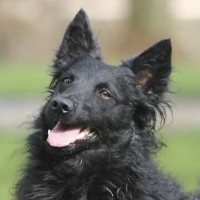Appearance of the Croatian Sheepsky
|
| The Croatian Sheepsky is a small to medium-sized dog with a rectangular silhouette and athletic build. The head of this hybrid is generally wedge-shaped, with a medium-length muzzle that is often tapered. They have medium-sized triangular ears that point and may or may not be erect, as well as almond-shaped eyes that are most often brown but can also be blue and multicolored, and generally have a lively, alert face and friendly expression. The Siberian Husky has a long, straight tail that extends behind him or hangs down when he's at rest, but the Croatian Sheepsky is often born without a tail, and those that have one wear it over their backs when they're alert. The double-layered coat consists of a thick, dense undercoat with either a medium-length coat of smooth, straight guard hairs or a soft, wavy coat. This crossbreed can come in many different colors, but black is generally more predominant than other colors. White markings are commonly seen on both parent breeds, so are likely to occur on the Croatian Sheepsky too. |
Temperament of the Croatian Sheepsky
|
| These are generally high-energy dogs with a strong work drive. Both parent breeds are intelligent and able to assess and react quickly to unexpected situations, part of the reason these breeds are able to do their jobs so well is their ability to work independently when needed. However, this dog can inherit a certain stubbornness, and training should start at an early age for best results. The Croatian Sheepsky is also an intelligent dog that can be reserved for strangers and, thanks to the Croatian Shepherd Dog, also serves as a guard dog. These crosses are also family pets, being much happier and healthier animals when fully integrated into the family unit. Croatian Sheepskies left alone for too long can develop separation anxiety. In most cases, this hybrid should get along with other dogs, however, there may be a tendency to chase other small animals. |
Needs and activities of the Croatian Sheepsky
|
| Both the Siberian Husky and the Croatian Sheepdog have been bred for their enthusiasm and stamina. A double dose of energy from both parent breeds ensures that the Croatian Sheepsky is a very active animal, and they don't slow down until they've decided they're done with whatever it is they're doing, whether it's herding cattle, training on agility courses, or chasing a ball. You want to make sure your Croatian Sheepsky gets at least an hour and a half to two hours a day of vigorous activity, although two would be even better. While this breed is unlikely to mind a walk or a run, they can also be well suited to alternative exercises such as flyball, Frisbee or dock jumping. Their high level of activity makes them much more suited to homes with yards than apartments. |
Maintenance of the Croatian Sheepsky
|
| Although both parent dogs have a double-layered coat of thick, dense undercoat protected by a layer of more waterproof guard hairs, the texture of the undercoat is quite different. Although they both have medium-length coats, the outer layer of the Siberian Husky will be stiff and straight, while the Croatian Shepherd Dog has a soft, wavy or curly coat. This means that if your dog resembles its Croatian Shepherd Dog parent in coat types, it will only need an occasional bath and regular brushing with a pin or smoother brush. If your dog has inherited a coat more reminiscent of the Husky range, bathing needs may still be infrequent, but brushing will be a daily requirement. Dogs with a more Husky-type coat will also shed more, and may have periods of heavy shedding in spring and autumn. |









 English (United Kingdom)
English (United Kingdom)